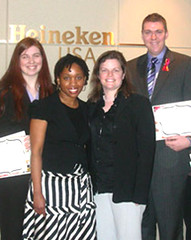In communication, especially advertising, there is no substitute for practical, hands-on experience. It’s something that underscores any class I teach.
I’m not alone in this belief, of course. There are several opportunities for college students to find experience across the country, including the American Advertising Federation (AAF).
Every year, the AAF hosts the National Student Advertising Competition (NSAC), which provides a candid, real world situation faced by a major account. More than more than 150 colleges and universities participate in the challenge. This year’s competition is being sponsored by AOL. (Good luck with that.)
While not as publicized as the NSAC, the AFF also hosts a Public Service Advertising Competition with Heineken USA (and this year, the Ad Council), which I wanted to lend some attention to today.
National Public Service Advertising Competition
Participants, which must be age 21 or older and members of an AAF college chapter, can submit their intent to participate by Jan. 15. The intent to participate form here.
Unlike the NSAC, the Heineken USA/AAF Public Service Advertising Competition allows students to enter as individuals or teams of up to three, providing even more flexibility. As participants, the students will produce print, radio and new media (demonstrating just how deep new media is taking hold).
Winners of the competition will receive $3,000 and a chance to pitch Heineken USA executives in White Plains, N.Y. (The second-place, third-place and up to five honorable mention campaigns also receive cash awards.) The winners will be announced in April, during Alcohol Awareness Month.
Why Experience Is Important For Students
As a student, it’s not always whether you win or lose (though winning can be pretty fun), but what you can take away. Despite already working in the field, one of my most memorable real life lessons came out of an advertising competition hosted at the University of Nevada, Reno (which now participates in NSAC).
Our class was randomly divided into two teams and asked to develop an advertising campaign for the Reno Philharmonic. It was fun, challenging, and provided some surprising true-to-life experiences that could never be duplicated in a regular class setting.
As “co-creative director” on the team, I learned that popularity sometimes influences what campaign is produced. Since my co-creative director lobbied the team for his spirited campaign, it became the one everyone wanted to produce.
I wasn’t so sure the campaign was right for the demographic, but had to admit that daring the maestro to conduct an orchestra from an Indy car or roller coaster was pretty creative. The judges thought so too. Our team won for creative prowess based on their scores.
Unfortunately, we lost the account based on the maestro’s comfort level with the campaign and the budget. As went the client, so went the competition.
Right on. It’s not always about being clever. Sometimes it's about connecting to the audience and, well, the account. That's something you don’t always learn in the classroom.

I’m not alone in this belief, of course. There are several opportunities for college students to find experience across the country, including the American Advertising Federation (AAF).
Every year, the AAF hosts the National Student Advertising Competition (NSAC), which provides a candid, real world situation faced by a major account. More than more than 150 colleges and universities participate in the challenge. This year’s competition is being sponsored by AOL. (Good luck with that.)
While not as publicized as the NSAC, the AFF also hosts a Public Service Advertising Competition with Heineken USA (and this year, the Ad Council), which I wanted to lend some attention to today.
National Public Service Advertising Competition
Participants, which must be age 21 or older and members of an AAF college chapter, can submit their intent to participate by Jan. 15. The intent to participate form here.
Unlike the NSAC, the Heineken USA/AAF Public Service Advertising Competition allows students to enter as individuals or teams of up to three, providing even more flexibility. As participants, the students will produce print, radio and new media (demonstrating just how deep new media is taking hold).
Winners of the competition will receive $3,000 and a chance to pitch Heineken USA executives in White Plains, N.Y. (The second-place, third-place and up to five honorable mention campaigns also receive cash awards.) The winners will be announced in April, during Alcohol Awareness Month.
Why Experience Is Important For Students
As a student, it’s not always whether you win or lose (though winning can be pretty fun), but what you can take away. Despite already working in the field, one of my most memorable real life lessons came out of an advertising competition hosted at the University of Nevada, Reno (which now participates in NSAC).
Our class was randomly divided into two teams and asked to develop an advertising campaign for the Reno Philharmonic. It was fun, challenging, and provided some surprising true-to-life experiences that could never be duplicated in a regular class setting.
As “co-creative director” on the team, I learned that popularity sometimes influences what campaign is produced. Since my co-creative director lobbied the team for his spirited campaign, it became the one everyone wanted to produce.
I wasn’t so sure the campaign was right for the demographic, but had to admit that daring the maestro to conduct an orchestra from an Indy car or roller coaster was pretty creative. The judges thought so too. Our team won for creative prowess based on their scores.
Unfortunately, we lost the account based on the maestro’s comfort level with the campaign and the budget. As went the client, so went the competition.
Right on. It’s not always about being clever. Sometimes it's about connecting to the audience and, well, the account. That's something you don’t always learn in the classroom.



















